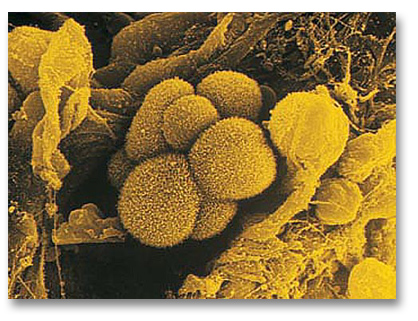- 7/19/2005
- Ann Arbor, MI
- press release
- EurekAlert (www.eurekalert.org)

University of Michigan researchers have figured out one more component in cancer cells’ aggressive growth—and hope that knowledge can help kill the cells. In the July issue of Cancer Cell, the scientists explain how cancer tumor cells attach themselves to a protein on the surface of cells lining blood vessel walls. When this attachment happens, it tells the cancer cell to grow and develop blood vessels, which feed the cell. Cun-Yu Wang, senior author on the paper, said this discovery could help in the fight against cancer.
“The blood supply is key for tumor growth and tumor development,” said Wang, the Richard H. Kingery Endowed Collegiate Professor at the U-M School of Dentistry. “If you cut off the blood supply, you stop cancer development.” Wang collaborated with researchers Qinghua Zeng, Shenglin Li, Douglas B. Chepeha, Jong Li, Honglai Zhang, Peter J. Polverini, Jacques Nor and Jan Kitajewski on the paper.
Scientists have heavily studied cancer cells’ secretion of proteins to form blood vessels. But Wang said when researchers tried to turn off that process, some tumors responded and some did not, which left him curious about how to develop a better treatment.
Rather than simply looking for a better way to interrupt the protein secretion, Wang and colleagues looked for other ways that tumor cells might develop their blood supply, a process called angiogenesis.
Wang’s team has studied hepatocyte growth factor, known as HGF, to better understand its function in the formation of cancerous tumors in the head and neck. Part of what HGF does is to get neighboring blood vessels to grow toward, and then into, the tumor.
What they did not know was how HGF got the process of angiogenesis started, said Zeng, first author on the paper and a research fellow at U-M.
So they looked at head and neck cancer cells to see if growth factors prompted the release of proteins related to angiogenesis. That led to an exploration of direct interaction between the tumor and endothelial cells. Blood vessels are lined by endothelial cells.
Examining data on the genes HGF activates, the team found that the one specific gene, called jagged1, is among the most expressed. Jagged1 binds to a specific protein on the surface of the endothelial cells.
Wang speculated that if jagged1 is not secreted but found on the surface of tumor cells, then perhaps HGF gets jagged1 levels to increase, and that prompts a connection between the tumor and endothelial cells.
Sorting out this connection, Wang considered involvement of notch, another protein on the endothelial cells. Notch is known to help in the formation of blood cells, and jagged1 binds to notch.
Wang said he found it interesting that although much research has looked at cancer cells’ secretion of proteins to form blood vessels, notch’s function in cancer angiogenesis has not gotten the same attention. Notch, Wang said, pulls this whole complex operation together.
After this contact stimulates angiogenesis, the tumor gets nutrition and grows faster, Wang explained. Conversely, Wang hopes that blocking the signaling pathway can cut off the tumor’s nutrition and stop its growth.
If this development pans out as a treatment, Wang said he envisions a two-pronged approach that attacks the protein secretion and the cell contact to kill cancer cells.
The next question Wang wants to explore is how these connections lead to metastasis, the spread of cancer throughout the body. He speculates that inflammation could trigger that pathway, and wants to look at the potential for controlling inflammation to stop tumor development.
“Head and neck cancer is under studied,” Wang said. “The five-year survival rate hasn’t improved in decades. We want to change that.”

Leave A Comment
You must be logged in to post a comment.